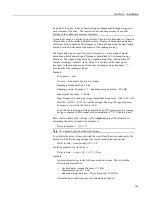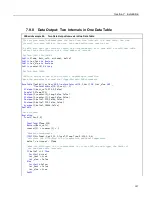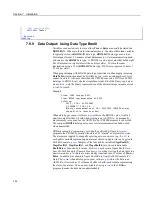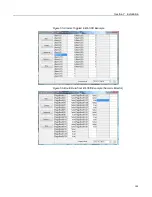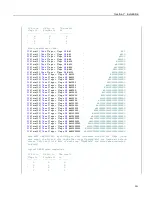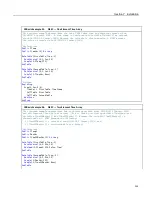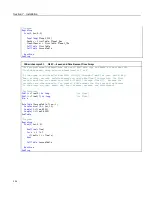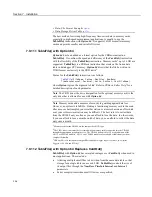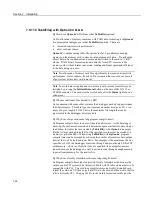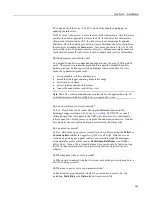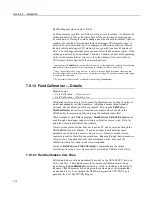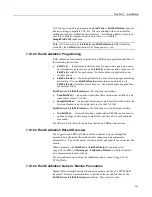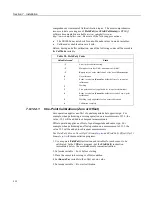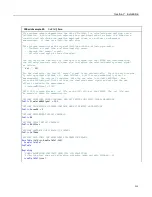
Section 7. Installation
•
Data-File Format Examples
(p. 379)
•
Data Storage Drives Table
(p. 373)
The best method for writing high-frequency time-series data to memory cards,
especially in high-speed measurement applications, is usually to use the
TableFile()
instruction with
Option 64
. It supports 16 GB or smaller memory
cards and permits smaller and variable file sizes.
7.9.11.1 TableFile() with Option 64
Option 64
has been added as a format option for the CRBasic instruction
TableFile()
. It combines the speed and efficiency of the
CardOut()
instruction
with the flexibility of the
TableFile()
instruction. Memory cards
1
up to 16 GB are
supported.
TableFile()
is a CRBasic instruction that creates a file from a data
table in datalogger CPU memory.
Option 64
directs that the file be written in
TOB3 format exclusively to the CRD: drive
2
.
Syntax for the
TableFile()
instruction is as follows:
TableFile
(FileName, Option, MaxFiles, NumRecs/
TimeIntoInterval, Interval, Units, OutStat, LastFileName)
where
Option
is given the argument of
64
. Refer to
CRBasic Editor
Help
3
for a
detailed description of each parameter.
Note
The CRD: drive (the drive designation for the optional memory card) is the
only drive that is allowed for use with
Option 64
.
Note
Memory cards add a measure of security in guarding against data loss.
However, no system is infallible. Finding a functioning memory card in the mud
after a moose has trampled your weather station or a tractor has run an offset disk
over your soil-moisture station may be difficult. The best rule is to collect data
from the CR1000 only as often as you can afford to lose the data. In other words,
if you can afford to lose a months worth of data, you can afford to collect the data
only once a month.
1
Memory cards for the CR1000 are the compact flash (CF) type.
2
The CRD: drive is a memory drive created when a memory card is connected into the CR1000
through the appropriate peripheral device. The CR1000 is adapted for CF use by addition of the
NL115 or CFM100 modules. NL115 and CFM100 modules are available at additional cost from
Campbell Scientific.
3
CRBasic Editor
is included in Campbell Scientific
datalogger support software
(p. 95)
suites
LoggerNet
,
PC400
, and
RTDAQ
.
7.9.11.2 TableFile() with Option 64 Replaces CardOut()
TableFile()
with
Option 64
has several advantages over
CardOut()
when used in
most applications. These include:
•
Allowing multiple small files to be written from the same data table so that
storage for a single table can exceed 2 GB.
TableFile()
controls the size of
its output files through the
NumRecs
,
TimeIntoInterval
, and
Interval
parameters.
•
Faster compile times when small file sizes are specified.
206
Summary of Contents for CR1000
Page 2: ......
Page 4: ......
Page 6: ......
Page 32: ......
Page 36: ......
Page 38: ......
Page 40: ......
Page 60: ...Section 4 System Quickstart Figure 16 PC200W View Line Graph 60 ...
Page 96: ......
Page 98: ...98 ...
Page 302: ......
Page 453: ...Section 8 Operation Figure 115 Using the Keyboard Display 453 ...
Page 456: ...Section 8 Operation Figure 118 Real Time Custom 456 ...
Page 457: ...Section 8 Operation 8 8 1 3 Final Memory Tables Figure 119 Final Memory Tables 457 ...
Page 458: ...Section 8 Operation 8 8 2 Run Stop Program Figure 120 Run Stop Program 458 ...
Page 460: ...Section 8 Operation Figure 122 File Edit 460 ...
Page 461: ...Section 8 Operation 8 8 4 PCCard Memory Card Display Figure 123 PCCard CF Card Display 461 ...
Page 478: ......
Page 506: ......
Page 536: ......
Page 636: ......
Page 642: ......
Page 644: ......
Page 676: ......
Page 677: ......


